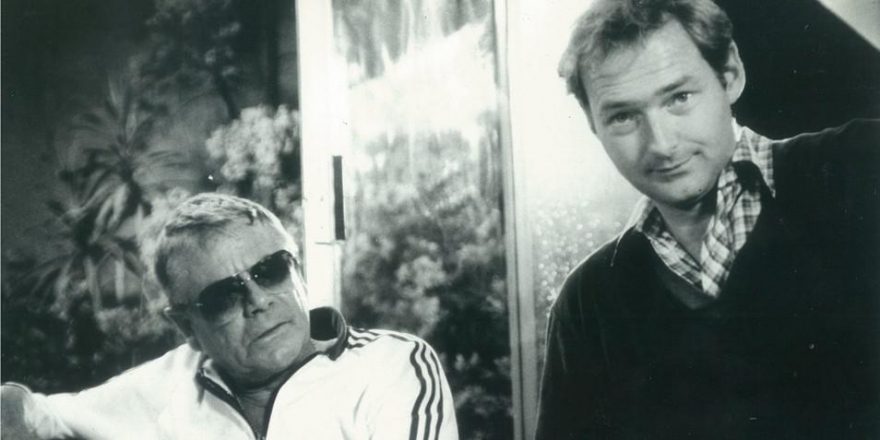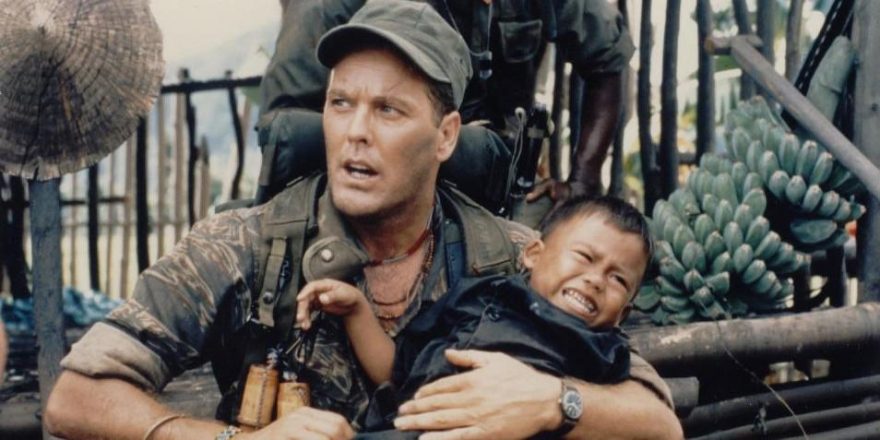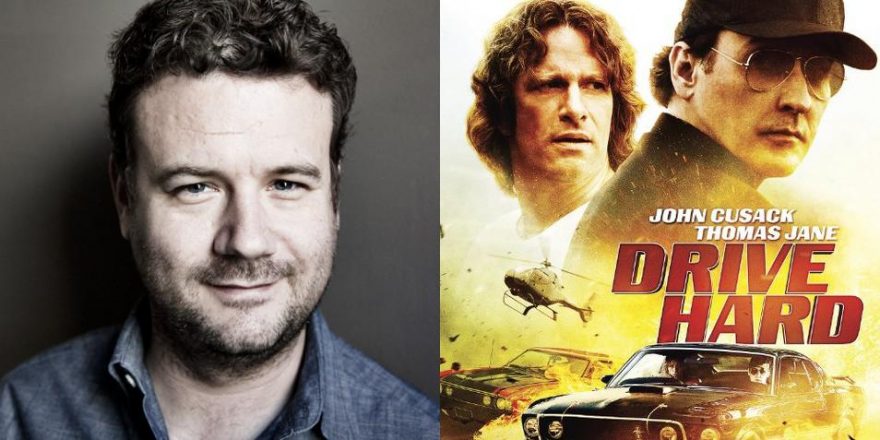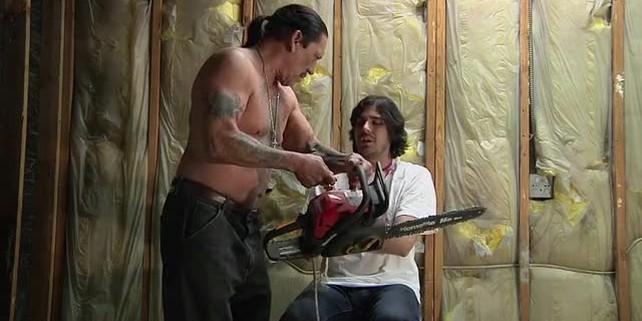That intimate moment has become my fondest memory from Day of the Assassin, a trainwreck of a movie I shot in Mexico 35 years ago. That, and doing a line of coke with The Rifleman, the law-and-order TV icon of the ’50s, who decided to cheer me up one night near the end of the shoot. For the record, the temporary euphoria was not worth the headache and loss of sleep, so I never became a cokehead. It’s a pernicious drug.
All directors, at some point in their career trajectory, find themselves hanging on to a runaway train. It’s Murphy’s Law. More often than not, The Movie from Hell is a co-production. Foreign locale, fast money, giant egos, high-pressure schedule — it makes a volatile witches’ brew, even before you factor in deep-rooted national resentments. A co-production is a business model designed to diminish trust between nations.
The trailer typifies the many leaden spy dramas of the times.
Mexico, Spain and the U.S. were the partners, which meant that the Spaniards felt superior to their Mexican brothers, and the Americans felt superior to everybody. Each country gave undertakings to deliver certain elements of cast or crew. Disputes arose immediately. Slated to direct was Leslie Martinson (More than 100 film and TV credits, an amazing career — he’ll be 100 years old in January) but he bailed when his deposit failed to arrive. He had directed Missile X: The Neutron Bomb Incident — an American-West German-Italian-Iranian-Spanish bowl of Europudding — for the same producer, so he probably saw the writing on the wall. His agent, who was also mine, immediately slotted me in there, so within a day the American producers, unbeknownst to me, offered their co-production partners a replacement director: “the man who made the last Bruce Lee movie.” I had in fact made a documentary about the late Bruce Lee, The World of Kung Fu. The Spanish and the Mexicans thought they were getting Enter the Dragon director Robert Clouse. Their disappointment was palpable when this misrepresentation became clear on the first day of prep in Mexico City. Must say, my sphincter tightened a little too. I had arrived in a war zone.
The next disappointment followed quickly. Jill St. John, a charming lady whom the Americans had promised as the female lead, got tired of waiting for her deposit and took off for the ski slopes of Aspen. The Americans were in default once again. So the Spanish producer had the right to the next choice. He chose his girlfriend, Susana Dosamantes, a talented local soap-opera queen, still popular in Latin television but whose name would not generate the same foreign sales interest as the Bond girl from Diamonds are Forever. The Americans ground their teeth.
During pre-production, as the bullets continued to fly around me, I had one thing to look forward to. On Day 1 of shooting, I would be working with one of my screen heroes, Glenn Ford, already in the 40th year of his career, with so many memorable roles behind him.
He had been hired fresh off playing Superman’s father. Fee: 100K for two days’ work. Pricy, but his name would elevate the marquee. He had also been promised that an actor friend of his, Taylor Lacher, would play a key supporting role. Unfortunately the American producers had also promised that role to the writer, to sweeten his meager fee. The writer learned about it the day Mr. Ford arrived, and was summarily demoted to non-speaking villain number three.
The writer — Robert Avard Miller — was a decent man, still in a lot of pain due to the death of his teenage son from leukemia. One night in a beachside bar in Ixtapa, he railed at the sky and challenged God to prove His existence by striking him dead with a thunderbolt. I shifted a little in my seat, but counted on God’s forbearance… or at least accuracy. A smart thunderbolt, perhaps? Does God do collateral damage? These were questions that ran through my mind as the challenge was repeated with mounting anger. But no thunderbolt came. God had a more lingering fate in store for both of us: Death by Co-Production.
When Mr. Ford arrived at the hotel, I was duly summoned to the suite and after cordial greeting was told that cue cards would be required for the big scene the next day. These cards would have lettering of a particular height and color; each of his lines must be preceded by the last three words of the other actor’s line in a different color. In the absence of volunteers, my wife and I made the cue cards ourselves.
Arriving on location for Day 1, I found Mr. Ford was not a happy camper. Probably because a tall camper-van had been provided to him, instead of the promised trailer. Furthermore, it was parked at the side of a six-lane highway beside the gate to the mansion location. The low arch over the gate prevented any vehicle above a certain height from entering. As I stepped inside, trucks thundered past, and the camper van shuddered. For some reason, the American producers had vanished for the morning.
In addition to his unhappiness, Mr. Ford was also wearing dark glasses, which he announced he would continue wearing throughout the scene.
“But, sir, it’s seven pages long and you are only in one other scene. The audience needs to see your eyes.”
“I can’t let my public see these eyes,” he replied, taking off the dark glasses momentarily, revealing somewhat bloodshot pupils.
“What happened?”
“I was up all night in the bathroom. I’m a little better now. But I can’t let them see these eyes.”
I said we would get eye drops immediately. How did he get Montezuma’s revenge? He had drunk the hotel tap water instead of the bottled water provided. In 1979, foreigners drank the local tap water at their peril, or to achieve rapid weight-loss. Everybody knew this. Glenn Ford had done five pictures in Mexico during his career. “But I like hot water…” was his explanation.
Making the star happy was the priority. I tried to get him a room in the mansion instead of the camper, but the company had hired only the large glass atrium to the building. The rest of the place was off-limits and the owners were away. It took till lunchtime to get him the room. Meanwhile, I started shooting everything I could without actually showing whether he was wearing dark glasses or not, in the hope I could persuade him that his eyes were now back to normal. I cited several points in the dialogue where he could shed them for dramatic reasons. The eye drops made the redness recede but not sufficiently for Mr. Ford. Crew looked at their watches. The sun would go behind a building at 4 p.m., making our totally glass-walled atrium hard to light. We might not make the day if I did not get on with the meat of the day’s work. Eventually, I committed to the dark glasses.
The “stay away… it will blow over” American producers returned. They did not care about the audience seeing Glenn Ford’s eyes. They only cared about his name on the poster. I was just another director who’d spent the morning jerking off. Now both sets of producers hated me.
I was determined to get those glasses off. I went to see Mr. Ford in the room we had procured for him. He had eaten his lunch, and was lying on a sofa looking very depressed. Sitting down in a chair beside him, I started by apologizing for the camper-van. This induced a sad litany of woe about his conditions, rate of pay, etc. — “I have never been treated like this,” still feeling ill — and more seriously, lack of confidence in his ability to play the scene, whereupon tears trickled down his cheeks.
Something made me think of my own father. I would hate to see him so unhappy. Or any man of that age. So I sat down on the sofa, and put my arms around him. I remember I said soothing words but cannot recall what they were, while a Hollywood legend wept on my chest. Then, in less than 15 seconds, he was feeling better. I got up, assured him with confidence that the scene would be great. Knowing, of course, that it would be at best a boring scene, functionally shot due to time constraints, full of convoluted exposition. Lordy! You mean directors lie to their cast? Shocking. Finally he agreed he would take his glasses off at the very end of the scene. As I hurried off, Chuck Connors (the stalwart hero from TV’s The Rifleman, 1958-63), who was playing opposite Glenn Ford in the scene, came in to see how he was.
Chuck was my guardian angel several times on the movie. This was the first occasion. A couple of minutes later, both men emerged from the room, Chuck his usual breezy self, but Glenn Ford noticeably brighter. No mention of sickness. Keen to work. Even jocular. We raced through the coverage facing the windows, just in time to beat the sun. The eagle-eyed can see Mr. Ford reading his lines from the cue cards at times, despite the dark glasses. We could then light Glenn Ford’s coverage against a windowless background. And the glasses finally did come off at the end of the scene. The eyes had lost their redness. Glenn Ford’s fan base was saved from trauma.
Later, Chuck told me he had offered Mr. Ford one of his amazing stomach-settling pills he always brought to Mexico.
“Is it natural?” Glenn Ford asked.
“Totally…” said Chuck, handing him an amphetamine.
He told me it always fixed a sick or insecure actor.
The next day — the scene of the betrayal and murder of Glenn Ford’s character — would be the Day of the Testicular Encounter referred to earlier. But first, a short digression.
Dare I say — take a long, hard look at that picture, which brings a new dimension to the term “woody”? Dr. Freud, your slip is showing. (I know, I’m a sick puppy….)
Somehow, I want to believe that the decision by the relevant executive at the publishing house back in the early ’60s to use this particular still as the front cover for a kids’ comic book was not a perversely funny accident; rather, it was the work of a subversive mind, devising a time-bomb joke for a cynical future generation to unearth. For nearly 50 years, his or her private irony has squeaked by without notice… till now. But no. Those were more innocent times. How could it have occurred to anybody involved? But if it had…. It would have made a good episode of Mad Men.
Glenn Ford was in good spirits on arrival for Day 2 of the Assassins shoot, his second and last scene in the picture. It also involved Taylor Lacher, the actor he had brought with him. They had become buddies on the set of Cade’s County, a high-profile but short-lived series in 1971.
I had actually visited the set of Cade’s County as promo producer for Australia’s Channel 9 Network, which had purchased the show, and watched Mr. Ford do a scene with cast regular Taylor Lacher. Little did I know as I observed Mr. Lacher discreetly from the side that I was watching an actor who would, nine years later, spit on the ground in front of me as a gesture of his contempt for a creative decision I had made. My directorial style does not normally produce this kind of response. I returned the compliment with full-load squibs for his death scene.
Day 2 was scheduled to finish early so trucks could take off for location in Ixtapa. Pressure was on to get through the betrayal and murder scene (only the climax to the whole story!) as fast as possible, with a Spanish D.P. who spoke no English. This movie was my personal Lost in Translation. I soon learned useful phrases like “Chingao! Donde esta el gringo pendejo?” Mexican crews are great, incidentally. A decade later, I did a bunch of episodes of Tarzán in Palanque with a fantastic crew.
So, fast forward to… Taylor has to pull a gun, harangue his Onassis-type boss (Glenn Ford), then shoot him. The first few setups went smoothly enough, then came the actual gun-firing moment. When he saw the armorer load the pistol, Mr. Ford’s mood changed. He came to me quite agitated, and stated that he had a mortal fear of firearms.
Puzzling, I thought, given the number of Westerns he had made. Pictures like The Fastest Gun Alive and Day of the Evil Gun. By reputation, he had the fastest draw of any Hollywood actor, firing at 0.4 of a second, faster than John Wayne or Gunsmoke’s James Arness.
He was a Captain in the Naval Reserve. In 1967, he volunteered to serve three months in Vietnam, spending some of his time under bombardment, and accompanying five Special Forces missions. So what’s the problem with the quarter-load blanks? He took up hang-gliding at the age of 64, for God’s sake! WTF!
As he was costumed in his own clothes (another smart decision by the American producers to save money), he was not prepared to be squibbed. He begged me to allow him not to be in any shot in which the gun was fired. I had hoped to have him pumped full of lead, Peckinpah-style. So much for that wild idea. I looked to a producer. He shrugged and walked off. Brave, brave Sir Robin.
Of course, actors have a right to be nervous around firearms. The tragic loss of Brandon Lee was a safety lesson to the whole industry. But I knew: You pick your battles. This was not one of them. So, I set it up as: an insert of the gun firing — cut to Glenn Ford clutching his chest, dropping out of frame — cut to a wide two-shot. He completes the fall, etc. After I called “Cut” on that shot, he got up and approached me, beaming from ear to ear. He put one arm round my shoulder to hug me. Then I felt his other hand cup my balls and give them a quick, gentle squeeze. “Oh, thank-you, thank-you so much for doing that, I really appreciate it…” I recall him saying. It was over in a flash.
I leaned forward, disguised my gasp as a laugh, “Whoa! Ho ho!” Just jocular locker-room humor, nothing to see here, folks. Of course, I did not think Glenn Ford was gay. He had brought with him wife number three (out of a total of four), actress Cynthia Hayward, also a cast member from Cade’s County. (She treated my wife, another beautiful but younger blonde, with lofty disdain.) There was nothing sexual in Mr. Ford’s act, rather it was a demonstration of power, a direct metaphor for our relationship during his two days of work. He had me by the short and curlies the entire time. Perhaps it was a parting handshake for satisfactory service. So the only way to take it was as a compliment. How many directors have had the privilege of getting their balls squeezed by a star from Hollywood’s Golden Age? I am deeply blessed.
By way of comparison, perhaps this is a good time to remind everybody of how a director/star relationship can develop.
I have a liking for incendiary moments of a different kind. I like to blow shit up, or at least set fire to it. Fire is a cheap enhancement to production value. The demise of the vehicle above produced one of many moments of unintentional hilarity in Day of the Assassin. Richard Roundtree’s car is forced off a cliff, plunging 300 feet into a quarry. I shot it in slow-motion. The sound editor laid a seemingly endless girly scream for the full length of the fall. Terrible thing to do to the original Shaft. But I was totally shut out of post production, which apparently degenerated into open warfare. The Mexican producers seized the negative. The American producers escaped to L.A. with the work print, which they edited on a Moviola, then generated a negative off the final cut, scratches and all. The resulting grain and sharp contrast they justified as the director’s vision.
On arrival in Mexico City, our passports were taken from us for visa processing — “Just a few days, nothing to be concerned about.” Seven weeks later, they showed no sign of returning. My wife and I developed a contingency plan should the movie collapse, freezing or losing our passports. We would take a bus to Juárez and phone Margaret’s brother Rick, a former El Paso police detective, who would drive across the border and collect us.
It helped that Chuck had a huge platonic crush on my wife. In my presence, he would occasionally pretend to be a vampire and try to bite her on the neck. (She has a lovely neck, by the way.) It was as close as he would ever come, he said, to playing a vampire on the screen, which was, in fact, his heart’s desire. But a hit Western series had typed him solely for gun-carrying roles.
Even though his politics were to the right of Attilla the Hun, we got on famously. He was a true Hollywood character. A former Brooklyn Dodger, Chuck was often a guest sports commentator on NBC till he accidentally dropped the “F”-bomb during a primetime live telecast, startling the nation, and endearing him further to his male fan base. Chuck told us not to worry about getting back across the border. He was an honorary Treasury Department agent, complete with badge, a rank awarded to him because of the Department’s affection for The Rifleman series. The Treasury Department windbreaker he wears in the movie was a gift from them. He would make a phone call if necessary, and we would be home. That’s a face that means business.
Matters finally came to a head in the sixth and last week. Still no passports, and producer Carlos Vassallo wanted the hero (Chuck) to participate in an armed robbery of a security truck and shoot the innocent guards. I pointed out the damage to audience identification with the hero. So I was fired. Vassallo took over the last few days of the shoot, and gave himself co-director credit in the territories he had sales rights to. Chuck just gave me that “It’s Chinatown” look. Later he commiserated with me over wine and cocaine. In vino, veritas. In powder, hubris. I prefer the vino.
Passports returned, and back in L.A., we got a call from Chuck to see how we were. He did not drop us, as many might have. We would meet occasionally for lunch before I returned to Australia two years later. Once he picked me up in his Mercedes, with a photo medallion of the Pope hanging from the rear view mirror, and a .357 Magnum in a cowboy holster mounted on the passenger side of the drive shaft, ready for a quick draw. Once a Rifleman, always a Rifleman. Vale, Chuck, you were a good man and you made your mark.























